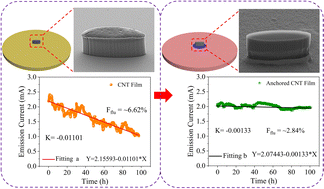Enhanced field emission stability of vertically aligned carbon nanotubes through anchoring for X-ray imaging applications†
Abstract
It remains difficult to obtain a carbon nanotube (CNT) emitter that simultaneously exhibits high current density, low fluctuation, and long service time because CNTs are easily detached from the substrate in a strong electric field due to the weak adhesion between direct-growth CNTs and heterogeneous substrates. Herein, a mold-aligned transfer anchoring method is employed to anchor vertically aligned CNT film and CNT arrays on a metallic substrate using silver conductive paint via an annealing process. After 100 h of continuous testing with an initial current of ∼2 mA and a current density of ∼900 mA cm−2, the decay rate of the emission current of the anchored CNT emitter decreased by ∼88%, and the current fluctuation was ∼57% lower than that of the unanchored CNT emitter. Furthermore, a metal wire with a width of ∼90 μm could be clearly distinguished by a CNT cold cathode X-ray imaging system. These results testify that the proposed anchoring method can significantly improve the stability and lifetime of CNT field emitters with a high current density, which provides a new route for developing the cold cathode of X-ray sources and other industrial applications in the vacuum electronics field.



 Please wait while we load your content...
Please wait while we load your content...